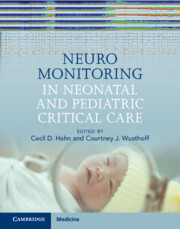Book contents
- Neuromonitoring in Neonatal and Pediatric Critical Care
- Reviews
- Neuromonitoring in Neonatal and Pediatric Critical Care
- Copyright page
- Contents
- Contributors
- Acknowledgements
- Part I General Considerations in Neuromonitoring
- Part II Practice of Neuromonitoring: Neonatal Intensive Care Unit
- Part III Practice of Neuromonitoring: Pediatric Intensive Care Unit
- Part IV Practice of Neuromonitoring: Cardiac Intensive Care Unit
- Chapter 13 Perioperative Monitoring for Congenital Heart Disease Surgery
- Chapter 14 EEG Monitoring in Neonates and Children Undergoing Extracorporeal Membrane Oxygenation
- Chapter 15 Neuromonitoring after Cardiac Arrest
- Part V Cases
- Index
- References
Chapter 13 - Perioperative Monitoring for Congenital Heart Disease Surgery
from Part IV - Practice of Neuromonitoring: Cardiac Intensive Care Unit
Published online by Cambridge University Press: 08 September 2022
- Neuromonitoring in Neonatal and Pediatric Critical Care
- Reviews
- Neuromonitoring in Neonatal and Pediatric Critical Care
- Copyright page
- Contents
- Contributors
- Acknowledgements
- Part I General Considerations in Neuromonitoring
- Part II Practice of Neuromonitoring: Neonatal Intensive Care Unit
- Part III Practice of Neuromonitoring: Pediatric Intensive Care Unit
- Part IV Practice of Neuromonitoring: Cardiac Intensive Care Unit
- Chapter 13 Perioperative Monitoring for Congenital Heart Disease Surgery
- Chapter 14 EEG Monitoring in Neonates and Children Undergoing Extracorporeal Membrane Oxygenation
- Chapter 15 Neuromonitoring after Cardiac Arrest
- Part V Cases
- Index
- References
Summary
Congenital heart disease (CHD) encompasses a large collection of cardiac malformations discovered at or before birth. CHD has an incidence of 4 – 50/1000 live births annually. One quarter of these require surgery shortly after birth. Newborn heart surgery has substantially changed since the modern era began with the adaptation of adult cardiopulmonary bypass (CPB) circuitry for infants. After decades of progress, the center of focus has now shifted from survival to the quality of life following newborn heart surgery (NBHS). Indeed, neurodevelopmental disabilities are now considered the single most common sequela of NBHS. Clinical management in the peri-operative period has a significant impact on the infants’ long-term outcomes. Consequently, neurological monitoring in the congenital heart disease population is increasing worldwide. With so many infants undergoing NBHS, the field of neuromonitoring for these patients is wide. In this chapter, we first review the neurological effects of hypothermia and the actual conduct of newborn heart surgery. We then discuss the indications for neuromonitoring and summarize its findings and outcomes in this unique population.
Keywords
- Type
- Chapter
- Information
- Neuromonitoring in Neonatal and Pediatric Critical Care , pp. 165 - 180Publisher: Cambridge University PressPrint publication year: 2022



